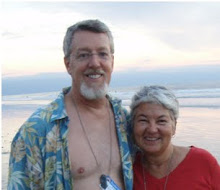The winds were from the southeast, so we began the trip by motorsailing directly into them, trying to get far enough east to be able to sail south toward Loreto. After about an hour, our engine overheated. When I stopped the engine to investigate, I discovered that the bolt holding the alternator bracket had sheared off. I tried to replace it with another bolt, but a broken piece of the original bolt was stuck inside the engine. I could not get it out and could not put in a new bolt because it was there. So there was no way to secure the alternator with a new bolt, which meant there was no way to tension the fan belt (which drives the water pump). I told Claudia the diesel engine was out of commission and we would have to sail to Puerto Escondido, where I knew we could find a mechanic.
Luckily, we were far enough east to be able to sail south toward Loreto, beating into the strong southeast breeze. We had to tack a bit to get far enough east to make our way around Isla Coronados, but we eventually made it down to Loreto, where we were able to establish an internet connection (using Telcel broadband) and send off an edited manuscript to my Swiss colleagues as we sailed past in the late afternoon.
As evening approached, however, the winds died. We were still several miles north of Puerto Escondido and were bobbing in the waves, going nowhere. Without an engine to take us into port, it looked like it might be a long night at sea.
We talked about using the dinghy and outboard to pull or push the boat, but before trying that I decided to look again at the engine and had an idea. Using twine, I managed to lash the alternator into place. This precarious repair allowed us to start the engine and make it into Escondido without overheating.

The good news was that, while motoring along slowly with the engine held together with twine, I managed to catch a 20 lb. skipjack tuna. It was a highlight of an otherwise frustrating day.

At Puerto Escondido, we were able to find a mechanic (Elvin on the vessel Sea Lover) who had the tools needed to extract the broken bolt from our engine block, so we were back in operation the next day.
We spent the following two days at beautiful Honeymoon Cove on Isla Danzante, which is only a few miles away from Puerto Escondido. Here is a picture of Sabbatical and the trawler Pacific in the cove.

On May 25th we ran out of propane and returned to Escondido to refill our propane bottle. We are there now, using the Singlar Marina WiFi connection to upload these blog posts. We plan to head south later this afternoon and work our way back to La Paz by next Sunday.

















































